Why some L.A. food banks are handing out Thanksgiving chickens this year
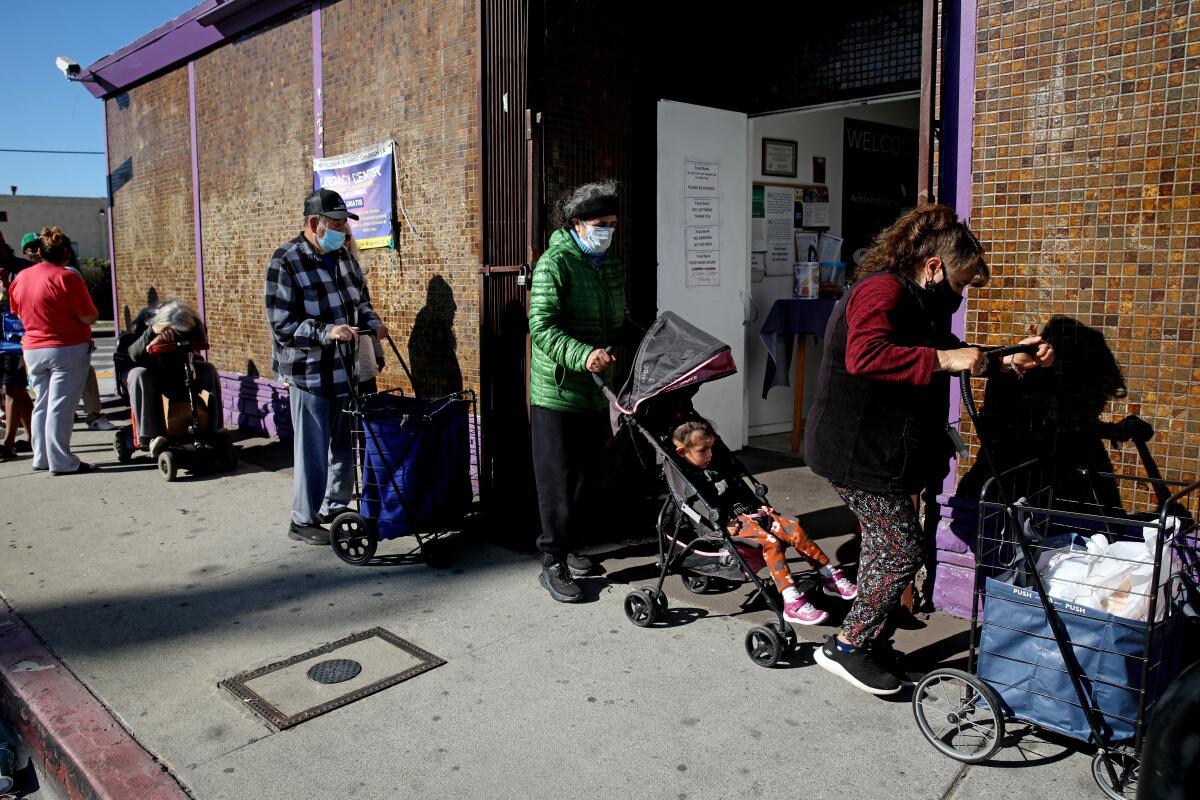
- Share via
Some Los Angeles food banks are so hard up this holiday season that they’re handing out Thanksgiving chickens instead of turkeys because of an economic crunch that is expected to continue straight through Christmas and into the new year.
Kenny Jones, director of People for Community Improvement, said he had no choice but to make the poultry swap at the nonprofit’s food bank in Willowbrook in the face of rising inflation and increased need since the COVID-19 pandemic began.
“We did a chicken pass-out last Thursday because we couldn’t afford the turkeys,” he said earlier this week. “We’ve seen more people come out this year, and we’ve just got to get more donations and help. … Everything has gone up — the food, the gas, the utilities, the insurance.”
These are common sentiments among those who work to provide food and other essentials to low-income Angelenos. Some report a falloff in donations of food and funds. Others, like Jones, say they don’t have enough volunteers to keep running smoothly during the busy holiday season.
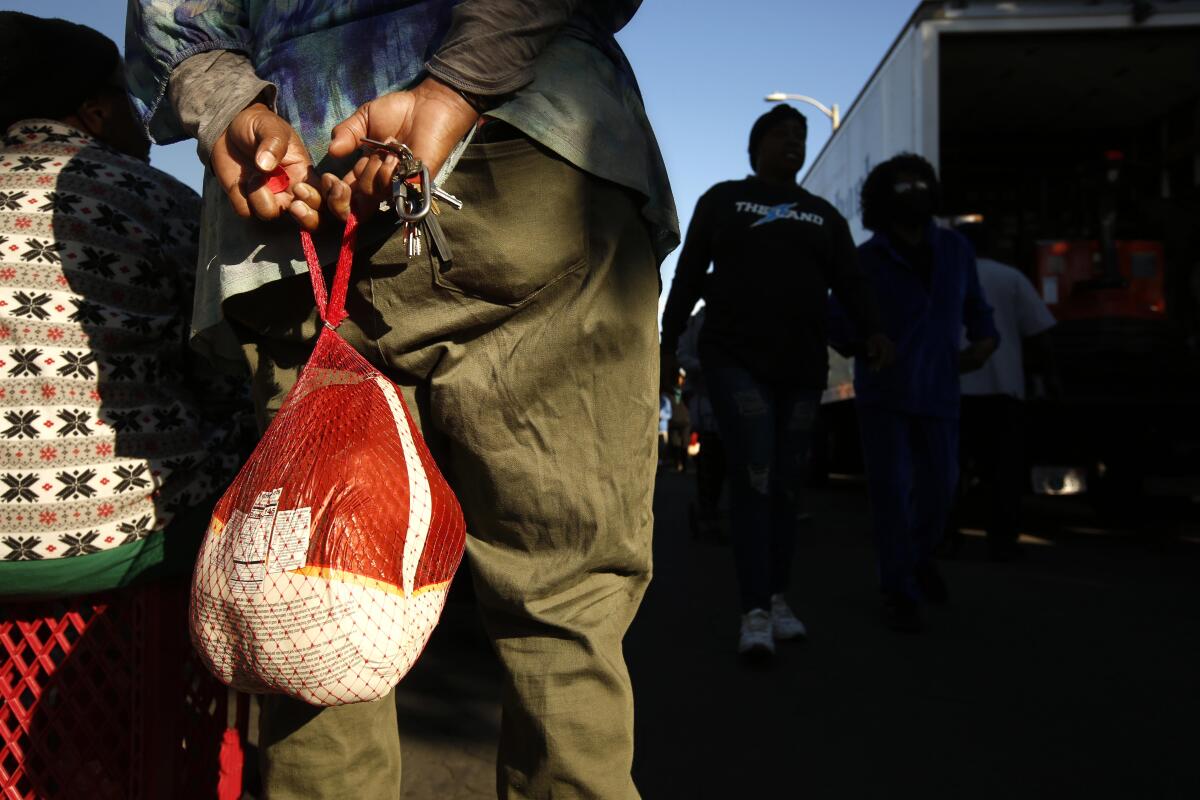
They all say they’re feeling the pinch this winter. For small, independently operated food banks, that can mean giving out lighter bags or even shutting down entirely. For some organizations that have managed to meet much of the need in their communities, it has meant offering less-traditional holiday food options.
Every Tuesday afternoon, Unity Fellowship of Christ Church Los Angeles distributes food to dozens of people who line up under a sign with the words “Love is for everyone” in black block lettering.
Two days before Thanksgiving, minister Art Miller, the coordinator of the church’s food pantry, oversaw a small team of volunteers who handed out pasta, stuffing, canned vegetables and fruit outside its modest storefront in West Adams.
In anticipation of Thanksgiving, Miller said the food bank had hoped to give out turkeys, as it’s done annually since it opened seven years ago. But it receives food from the Los Angeles Regional Food Bank, which has distributed thousands fewer turkeys to food banks this month than in past Novembers.
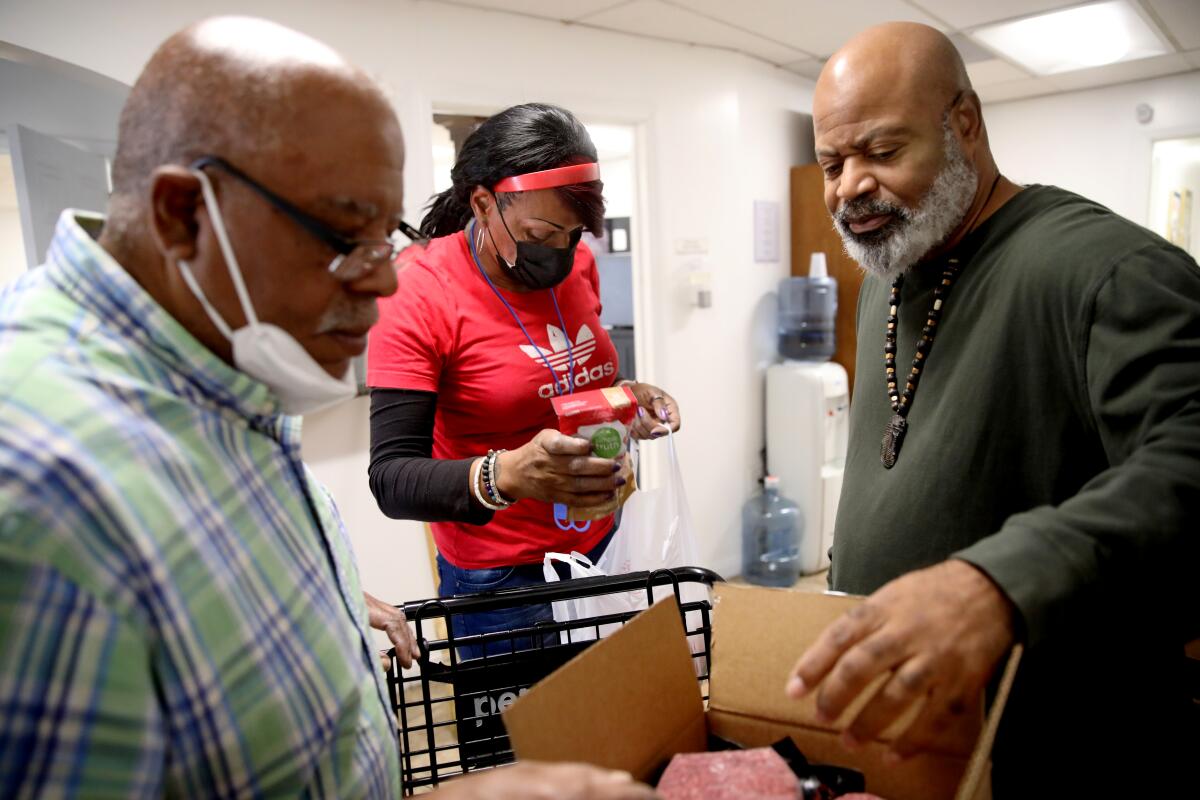
As a result, many of the people relying on the bags of food they picked up Tuesday at the West Adams food bank will instead serve chicken or fish for their Thanksgiving meals.
That’s fine by Monique Smith, who lives nearby and said she has been visiting the food bank for two years. On Tuesday, the 51-year-old tucked plastic grocery bags weighed down with cans and boxes into a pink patterned roller bag she had dragged to the distribution table after the line died down.
“I’m low on food and day after tomorrow’s Thanksgiving,” she said. “I don’t know what I’d do without this.”
Michael Flood, chief executive of the Los Angeles Regional Food Bank, said it is feeding more than 800,000 hungry Angelenos monthly — down from a peak of more than 1 million per month early in the pandemic. The nonprofit distributes food directly to people and to more than 600 food banks and pantries, churches and other nonprofits across L.A. County.
But Flood said that, for his organization, it’s a “constant struggle to try to meet the overall need and the overall demand for food,” especially given steep inflation and sustained demand in recent months. The avian flu outbreak, which contributed to the lower availability of turkeys nationwide , and food supply chain issues have made it harder for the organization to source certain foods.
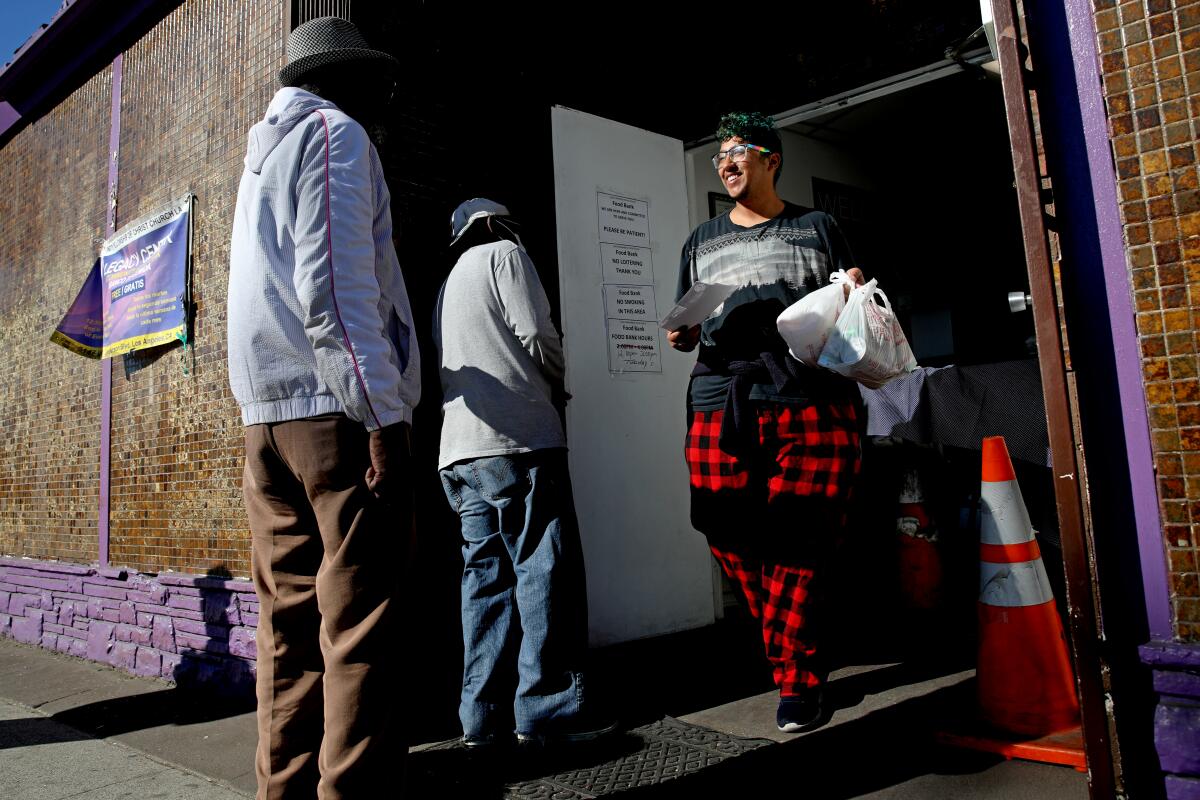
It was able to obtain only five truckloads of turkeys during the lead-up to this Thanksgiving, versus the 10 or so it has purchased in previous years, Flood said.
“This year, the supply is less,” he said. “We’ve been purchasing truckloads of frozen chicken so there can be at least some meat protein option for families celebrating the Thanksgiving holiday.”
Food donations have also dropped at L.A. County’s Aging & Disabilities Department facilities. A spokeswoman for the department said the number of people needing food at many of its community and senior centers has increased over the last year. At the same time, she said, many of the centers are still receiving fewer food donations than they did before the pandemic, a decrease some have chalked up to inflation.
During the pandemic, more than one-fifth of Californians faced food insecurity daily, according to researchers at Northwestern University.
Statewide, before COVID-19 disrupted millions of residents’ livelihoods, more than 15% of households with children experienced food insecurity. That figure nearly doubled in the early days of the pandemic, according to the California Assn. of Food Banks.
The state has provided hundreds of millions of dollars in funding for food banks over the last decade. In the 2022-23 state budget Gov. Gavin Newsom signed in June, more than $100 million was allocated to support food banks. Companies, foundations and individuals donate millions of dollars to L.A. County food banks each year.
But the need for nutritional food in this city is often simply too high. These are lean times for many food banks and pantries.
People for Community Improvement provides bags of food to hundreds of families each week. Jones, the group’s director, said its food bank is still trying to recover from the economic effects of COVID-19.
“Since the pandemic, it’s been really hard to get back going. That’s the hard part. Before the pandemic we had eight people, and now we’re down to three [workers] so that’s been a struggle,” he said. “We don’t have to turn people away. … But it’s been pretty hectic.”
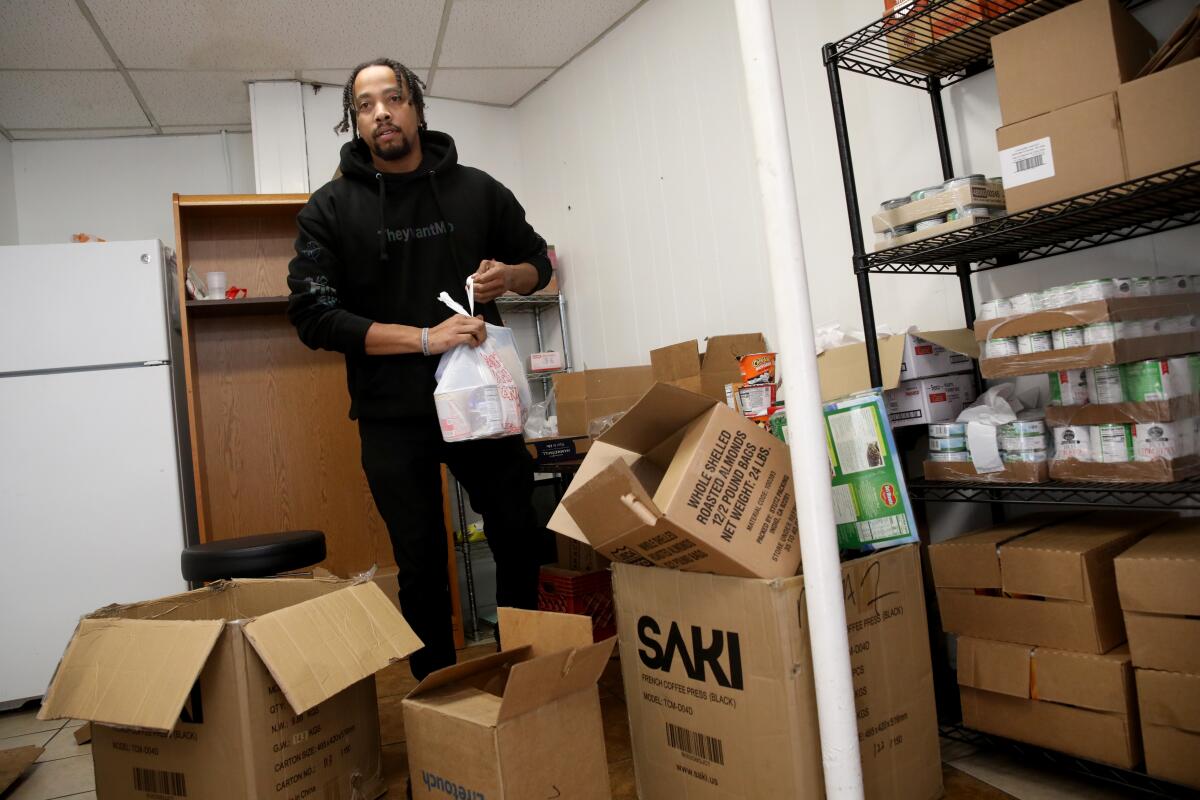
Morice Jones, a volunteer at Unity Fellowship of Christ Church’s food bank, kept the dry goods distribution table moving this week.
“You can have another mac and cheese,” he told an older woman with a walker as she turned to leave with less than her allotted amount. “Go ahead.”
He said one reason the holidays are so busy for food banks is because of the added pressure and expenses that the season brings.
“I feel like a lot of people come forward at this time of year because they may not otherwise want to admit that they need help,” he said. “But sometimes at the holidays is when they let their pride go because they don’t want to let down their families.”
Outside the West Adams church a few minutes later, Mark Darby held bags of groceries from its food bank and listened to music on tiny earbuds as he waited for a ride home.
He and his disabled brother have relied on food banks for years, the 59-year-old said, but their need grew during the pandemic as their monthly housing, utilities and food costs swiftly rose. Rising inflation has only made their circumstances more difficult.
“We pay an enormous amount for rent and when we get through, we’re broke. That leaves very little for vittles,” he said. “But I’m blessed, I’m getting through. With the help of food banks, the cupboards are never bare.”
More to Read
Sign up for Essential California
The most important California stories and recommendations in your inbox every morning.
You may occasionally receive promotional content from the Los Angeles Times.











